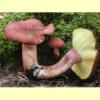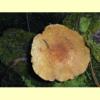
images/Tricholomopsis_rutilans/Tricholomopsis_rutilans_KRT2757.jpg
Medium to large agaric, growing on wood, with a white or cream to yellow spore print. Pileus yellow, red or pink, purple, rarely brown, strigose or with fibrillose scales, not viscid. Lamellae adnexed, adnate or sinuate or notched. Stipe central, rarely excentric. Partial veil remnants absent. Spores hyaline, non-amyloid, smooth; germ pore absent. Cheilocystidia present. Lamellar trama regular. Pileipellis a cutis or a trichoderm. Clamp connections present.
Differs from other robust pale-spored agarics, such as
Tricholoma, by its occurrence on wood. A distinctive field character is the dense fibrils on the pileus, often aggregated into scales, which are found in some species of
Gymnopilus (with a brown spore print),
Panus (lamellae decurrent),
Cyptotrama aspratum (orange or yellow, lacking purple or red tints) and
Neolentinus dactyloides (arising from a pseudosclerotium after fire).
Tricholomopsis Singer, Schweiz. Z. Pilzk. 17: 56 (1936).
One species: Tricholomopsis rutilans.
Tricholomopsis rutilans (Schaeff. : Fr.) Singer, Schweiz. Z. Pilzk. 17: 56 (1939).
W.A., S.A., Qld, N.S.W., Vic. and Tas. (and probably also N.T.).
In native forests.
On wood.
Saprotrophic.
Bougher, N.L. (2009a),
Fungi of the Perth region and beyond: a self-managed field book, Western Australian Naturalists' Club (Inc.), Perth. [
Description and
Illustration of
T. rutilans]
Bougher, N.L. & Syme, K. (1998), Fungi of Southern Australia. University of Western Australia Press, Nedlands. [Description, Illustration and Microcharacters of T. rutilans]
Breitenbach, J. & Kränzlin, F. (eds) (1991), Fungi of Switzerland. Volume 3. Boletes and Agarics 1st part. Edition Mykologia, Lucerne. [Illustration, Description and Microcharacters of T. rutilans from Europe]
Fuhrer, B. (2005), A Field Guide to Australian Fungi. Bloomings Books, Hawthorn. [Description and Illustration of T. rutilans]
Grgurinovic, C.A. (1997a), Larger Fungi of South Australia. The Botanic Gardens of Adelaide and State Herbarium and The Flora and Fauna of South Australia Handbooks Committee, Adelaide. [Description, Illustration and Microcharacters of T. rutilans]
McCann, I.R. (2003), Australian Fungi Illustrated. Macdown Productions, Vermont. [Illustration of T. rutilans]
Young, A.M. (2005b), A Field Guide to the Fungi of Australia. University of New South Wales Press, Sydney. [Description and B&W Illustration of T. rutilans]




